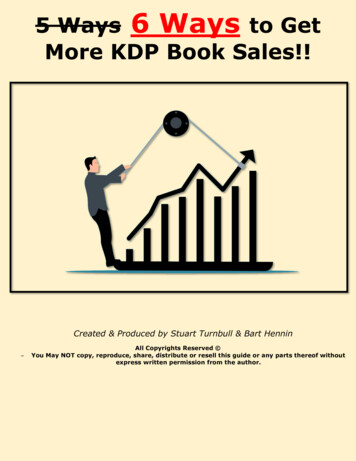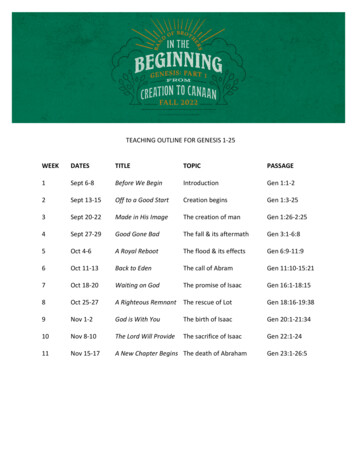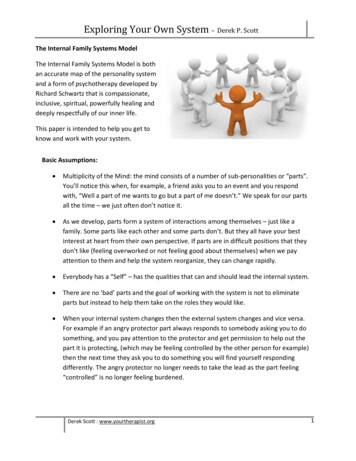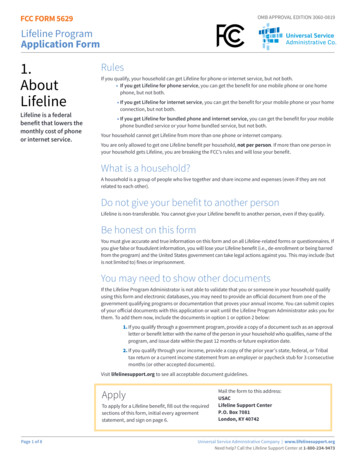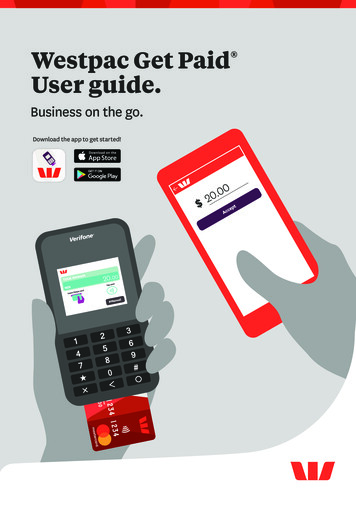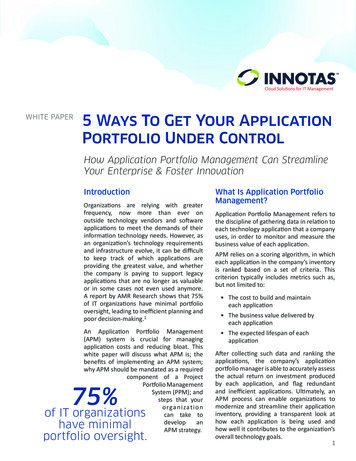
Transcription
WHITE PAPER5 Ways To Get Your ApplicationPortfolio Under ControlHow Application Portfolio Management Can StreamlineYour Enterprise & Foster InnovationIntroductionOrganizations are relying with greaterfrequency, now more than ever onoutside technology vendors and softwareapplications to meet the demands of theirinformation technology needs. However, asan organization’s technology requirementsand infrastructure evolve, it can be difficultto keep track of which applications areproviding the greatest value, and whetherthe company is paying to support legacyapplications that are no longer as valuableor in some cases not even used anymore.A report by AMR Research shows that 75%of IT organizations have minimal portfoliooversight, leading to inefficient planning andpoor decision-making.1An Application Portfolio Management(APM) system is crucial for managingapplication costs and reducing bloat. Thiswhite paper will discuss what APM is; thebenefits of implementing an APM system;why APM should be mandated as a requiredcomponent of a ProjectPortfolio ManagementSystem (PPM); andsteps that yourorganizationcan take todevelopanAPM strategy.75%of IT organizationshave minimalportfolio oversight.What Is Application PortfolioManagement?Application Portfolio Management refers tothe discipline of gathering data in relation toeach technology application that a companyuses, in order to monitor and measure thebusiness value of each application.APM relies on a scoring algorithm, in whicheach application in the company’s inventoryis ranked based on a set of criteria. Thiscriterion typically includes metrics such as,but not limited to: The cost to build and maintaineach application The business value delivered byeach application The expected lifespan of eachapplicationAfter collecting such data and ranking theapplications, the company’s applicationportfolio manager is able to accurately assessthe actual return on investment producedby each application, and flag redundantand inefficient applications. Ultimately, anAPM process can enable organizations tomodernize and streamline their applicationinventory, providing a transparent look athow each application is being used andhow well it contributes to the organization’soverall technology goals.1
Benefits Of ApplicationPortfolio ManagementHow APM Works With ProjectPortfolio Management (PPM)IT departments typically spend 75% oftheir time, budget and resources sustainingexisting operations, or “keeping the lights on,”and only 25% on new strategic initiatives.2APM relies on many of the same principlesas Project Portfolio Management (PPM), andcan easily integrate with an organization’sexisting PPM process.Many of these operational expensescan be eliminated when an organizationcommits to reducing reliance on outdatedor redundant applications. According to aCapGemini Application Landscapereport, 20% of the ant, and halfof CIOs surveyedbelieve that asmany as half of theapplications in theircurrentportfoliosshould be retired.3PPM refers to a process for managing specificprojects within the IT department, usingmetrics to analyze the cost-effectiveness andbusiness value of each existing and proposedproject by measuring how manyresources will be needed tosupport each venture,and their anticipatedor actual return oninvestment. The processshould illustrate howmuch employee demandis required to undertakeeach development project,and should specify whichapplications will be used to completethe project.20%of the typicalglobal organization’sapplications areredundant.By deploying an effectiveAPM system, an organization canstrategically determine which applicationsare proving their business value, eliminatethose that do not meet the business’ needsor strategic business goals, as well as supportthe development of a forward-thinkingapproach to application management thatincorporates valuable existing applicationsand focuses on building an applicationinventory with the flexibility to adapt andscale to meet future business needs.2As a result, an APM system does helpbusinesses evaluate IT expenses to moreeffectively deploy their resources, allowingthem to free up more of their IT budget toinvest in new projects that will contribute totheir companies’ strategic goals and ensurethat they are investing in modern, scalabletechnology.In order to gain more transparency in thePPM process, an enterprise’s APM strategyshould be aligned with its PPM approach.APM can be used within the PPM processto identify applications that are not costeffective, so that they can be eliminated orreplaced. This will ensure that each newdevelopment project relies on the mostefficient technological resources at thecompany’s disposal.
5 Key Strategies to Manage Application PortfolioUse this five-step process to assess and manage your company’s own application portfolio:1. Create a full inventory of all applications.2. Eliminate redundant applications.3. Identify the business value and function of eachapplication.4. Map your applications in a TIME chart.5. Optimize your resources against your applications.1. Create a full inventory of all theapplications used or owned by yourcompany.Categorize and rationalize each applicationthat has been used in the past, is currently inuse or has been proposed for future projects.Take note of the cost to operate eachapplication, the function it performs, whichother applications it is used with concurrentlyand which projects it is used to support. Asthis can be a large undertaking, you may wishto initially focus on inventorying applicationsthat are being used for current projects beforeanalyzing applications that are infrequentlyused.2. Eliminate redundant applications.Once the inventory is completed, you shouldhave a good perspective of which businessfunctions are performed by each application,and whether there are applications withduplicate functions. In this process, youare likely to find that a number of legacyapplications are used to perform tasksthat overlap with the capabilities of newapplications. Take this opportunity toeliminate such redundant applications,which may result in significant cost-savingsfor the IT department.3. Identify the business value andfunction of each application.After eliminating applications that are clearlyredundant, you can now assess the value ofeach remaining application by analyzing itsbusiness value. Rather than focusing solelyon financial concerns, your organization musttake a comprehensive overview to determinethe value generated by each application. Todo this, each IT application should be scoredon six separate criteria: strategic alignment,business process impact, architecture, directpayback, risk and customer/revenue.3
4. Map your applications in a TIMEChart.applications are able to function at thehighest level.Migrate/Modernize/Remediate - Thisapplication category refers to technologiesthat involve software that is no longersupported, or rely on a small group of humanresources with specialized knowledge.For applications in this category, CIOsmust consider action plans for updatingtechnology to fill the roles currently filled bythese applications.TIME Chart in Innotas APMOnce the business value and function of eachapplication has been identified, determinewhere each application fits in a TIME Chart,based on Gartner’s Portfolio Triage process.4The TIME Chart consists of four high-levelcategories:Tolerate - The applications in this group arethose that deliver business value, but are notnecessarily built on modern platforms or wellintegrated with the company’s infrastructure.Such applications are candidates for futureelimination, but should be used until the ITteam has determined the best alternatives.4Invest/Innovate/Integrate - This groupingof applications are those which show greatpromise to deliver significant businessvalue, but will require the company toinvest in integrating or upgrading existinginfrastructure to ensure that theseEliminate - In addition to redundantapplications, you may find in your scoringthat some of the applications in yourinventory have little to no business value, orthat the costs of operating the applicationfar outweigh the results delivered. In thesesituations, such applications should bemarked for elimination.After completing a TIME Chart, yourorganization will have a clear perspectiveof where each application fits into the ITprocess, and what steps should be taken tomaximize the business value of each one.5. Optimize your resources againstyour applications.At this point, you should have a goodoverview of the costs and resources involvedin operating each application. Now, workto maximize efficiency in each applicationprocess by ensuring that your human supplychain are effectively deployed and managed.A resource management platform can beused to monitor and track inefficiencies in theprocess, and to implement highly effectiveand transparent work process systems.
An Overview of the Innotas ITGovernance SolutionWhile it is possible to implement a proprietary APM system without the aid of software tools,making use of an APM system such as the one offered by Innotas can provide in-depth analysisof complex data sets, resulting in a comprehensive set of directives for APM improvement.Innotas APM offers a cloud-based, comprehensive set of functions that enable CIOs toseamlessly manage application and project portfolios, such as: Service request management Application portfolio managementBy integrating with an existing service deskor for tracking application enhancements,bug fixes or work requests, you can managethese requests using the Innotas solutionand gain a complete view for better decisionmaking and effective IT Governance within asingle data repositoryAchieve the best use of IT budgets andresources through full visibility into ITapplications. Model your applicationportfolio based on user-defined specifics,then use simple, customer scoring algorithmsto prioritize it. Track your human resources through realtime resource capacity and demand datadeveloped from defined fields such asinitiative, role and others. You can fulfillresource assignments automatically andaccess a single view of resource allocation.Application managementMeasure and manage the value of ITapplications by understanding their totalcost of ownership, resource planningrequirements, and aligning work withbusiness goals based on accurate real-timeinformation.APM Dashboard Resource managementAPM HierarchyThe Innotas APM solution can be rapidly deployed and can scale to meet the demands ofany organization — enabling enterprises to streamline their applications and improve theirtechnology processes to support business growth.5
ConclusionThe practice of APM is relatively new. Today, few organizations havedeveloped comprehensive data related to their applications’ cost, associatedresources and how well they meet business goals.However, this is rapidly changing: Gartner estimates that by 2015, at leasthalf of large organizations will be assessing business value relative toapplication costs and risks as part of the IT budget process on a regularbasis.5In order to ensure organizational maturity, it’s recommended that anAPM process should be considered as part of the overall IT strategy. Thedevelopment of a long-range plan for eliminating redundant or low-valueapplications while migrating or modernizing outdated technologies andinvesting in applications with a modernized infrastructure will help drivethe business forward.If an organization’s application stack is not actively managed, theorganization loses the ability to remain agile and innovative, and will fallbehind competitors. By implementing a comprehensive and effective APMprocess today, your enterprise can make the technological transformationsthat will help it stay ahead of the curve tomorrow.Sources:1 “The Product Lifecycle Management Market Sizing Report, 2007–2012,” AMR Research, 2012.2 “Key Issues for Application Portfolio Management,” Gartner, 2010.3 “Application Landscape Report 2011 Edition,” CapGemini, 2011.4 “Application Portfolio Triage: TIME for APM,” Gartner, 2010.5 “Key Issues for Application Portfolio Management, 2010,” Gartner, 2010.About Innotas:Innotas provides a ground-breaking cloud-based IT Governance solution — aneasy-to-use, rapid-to-deploy, and cost-effective way to manage resources and budgets across an ITdepartment’s entire inventory of projects, portfolios, applications, assets, and service requests. Withits strong foundation in Project Portfolio Management and Application Portfolio Management, Innotasprovides CIOs and IT managers with visibility across both strategic initiatives and sustaining operationsfor improved decision making across the entire IT portfolio.Innotas111 Sutter Street, Suite 300San Francisco, CA 94104Tel: 1.415.263.9800Toll-free: 1.866.692.7362www.innotas.com - info@innotas.com6Copyright 2012, Innotas. All rights reserved. Innotas is a trademark of Innotas, a California company. Other names used herein may be trademarks oftheir respective owners. Innotas WP APM 2012-12-12
An Application Portfolio Management (APM) system is crucial for managing application costs and reducing bloat. This white paper will discuss what APM is; the benefits of implementing an APM system; why APM should be mandated as a required component of a Project Portfolio Management System (PPM); and steps that your organization can take to
